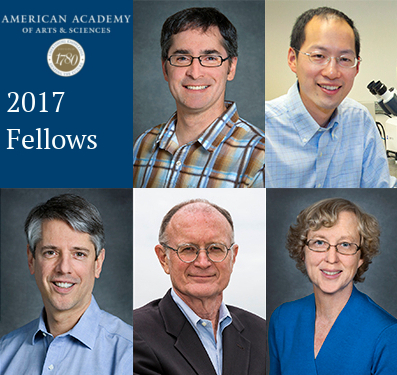The American Academy of Arts and Sciences announced today (Wednesday, April 12) the election of 228 members, including 188 fellows, five of whom are scientists at the Department of Energy’s Lawrence Berkeley National Laboratory (Berkeley Lab).

Clockwise from top, Jamie Cate, Christopher Chang, Katherine Yelick, Michael Witherell, and Roger Falcone have been elected to the American Academy of Arts and Sciences. (Credit: Berkeley Lab)
The honorary society recognizes leading figures in academia, the arts, science, business, and government. Fellows and foreign honorary members are nominated and elected to the academy by current members.
The new fellows from Berkeley Lab are Jamie Cate, Christopher Chang, Roger Falcone, Michael Witherell, and Katherine Yelick. All hold joint faculty appointments at UC Berkeley.
Jamie Cate is a faculty scientist in the Molecular Biophysics and Integrated Bioimaging Division and a UC Berkeley professor of molecular and cell biology. His lab focuses on studies of protein synthesis, including the actions of ribosomes in gene translation and protein folding.
Christopher Chang is a faculty scientist in the Chemical Sciences Division and UC Berkeley professor of chemistry and of molecular and cell biology. His area of research includes the fundamental design and synthesis of new molecules and materials, including artificial metalloenzymes. Chang is also an investigator at the Howard Hughes Medical Institute.
Roger Falcone is director of the Advanced Light Source and a UC Berkeley professor of physics. His expertise is in the use of ultrafast X-ray pulses and laser light to study condensed matter and atomic physics.
Michael Witherell is director of Berkeley Lab and a UC Berkeley professor of physics with expertise in high-energy physics. He is part of an international team that designed the LUX-Zeplin project to conduct next-generation dark matter experiments.
Katherine Yelick is associate lab director for Computing Sciences and UC Berkeley professor of electrical engineering and computing sciences. She is recognized internationally for her expertise in high-performance computing. Her research area includes parallel programming languages, performance analysis, and optimizing compilers.
“It is an honor to welcome this new class of exceptional women and men as part of our distinguished membership,” said Don Randel, chair of the academy’s Board of Directors in a press statement. “Their talents and expertise will enrich the life of the academy and strengthen our capacity to spread knowledge and understanding in service to the nation.”
Founded in 1780, the American Academy of Arts and Sciences is one of the country’s oldest learned societies and independent policy research centers. Its members, comprised of scholars and practitioners from mathematics, physics, biological sciences, social sciences, humanities and the arts, public affairs, and business, are called upon to respond to the challenges facing the nation and the world.
Current academy research focuses on education, the humanities, and the arts; science, engineering, and technology policy; global security and international affairs; and American institutions and the public good.
The new class will be inducted at a ceremony on Oct. 7 in Cambridge, Mass.
###
Lawrence Berkeley National Laboratory addresses the world’s most urgent scientific challenges by advancing sustainable energy, protecting human health, creating new materials, and revealing the origin and fate of the universe. Founded in 1931, Berkeley Lab’s scientific expertise has been recognized with 13 Nobel prizes. The University of California manages Berkeley Lab for the U.S. Department of Energy’s Office of Science. For more, visit www.lbl.gov.
